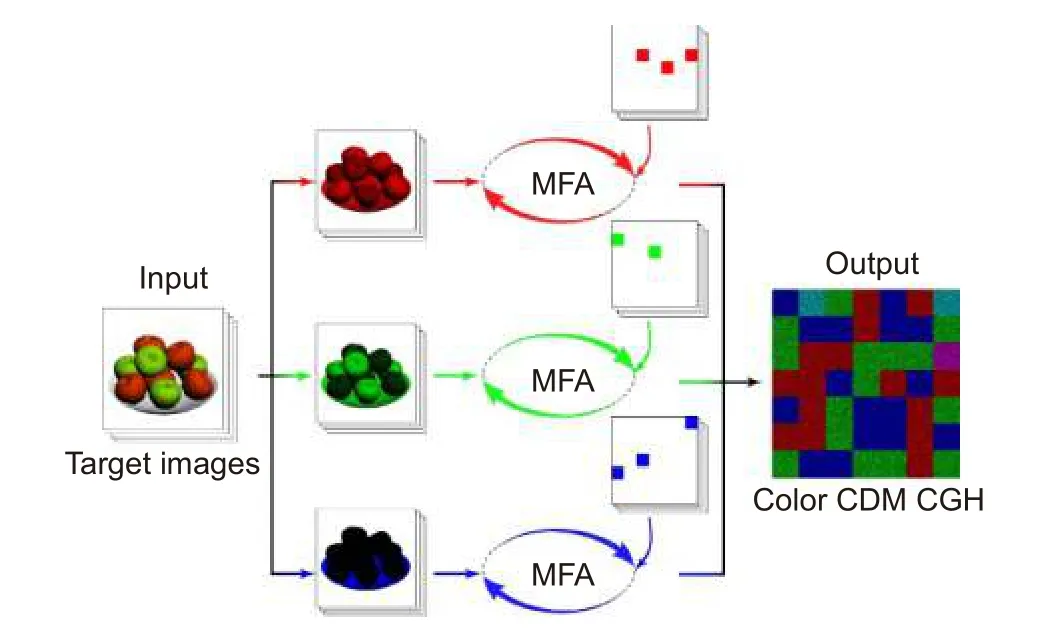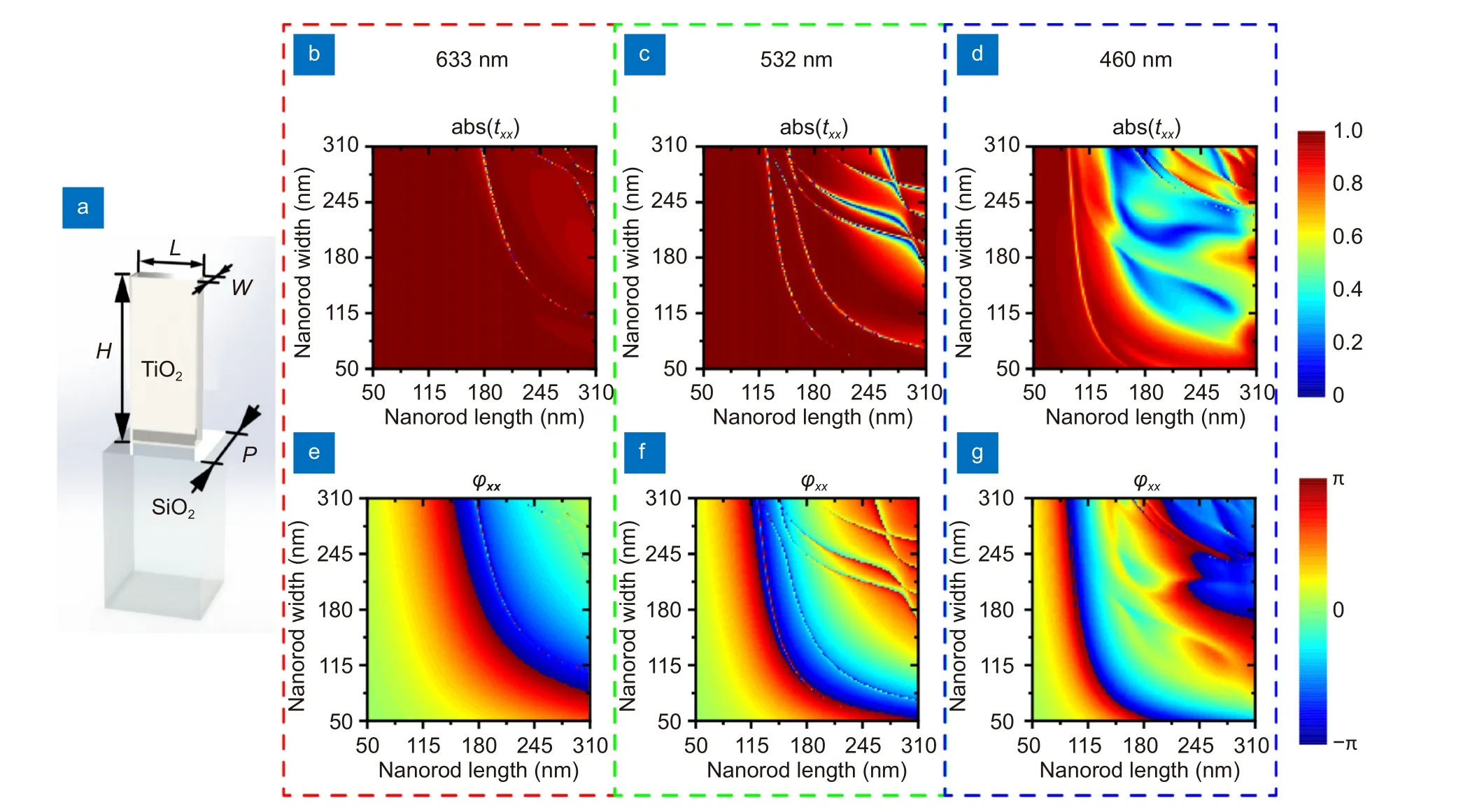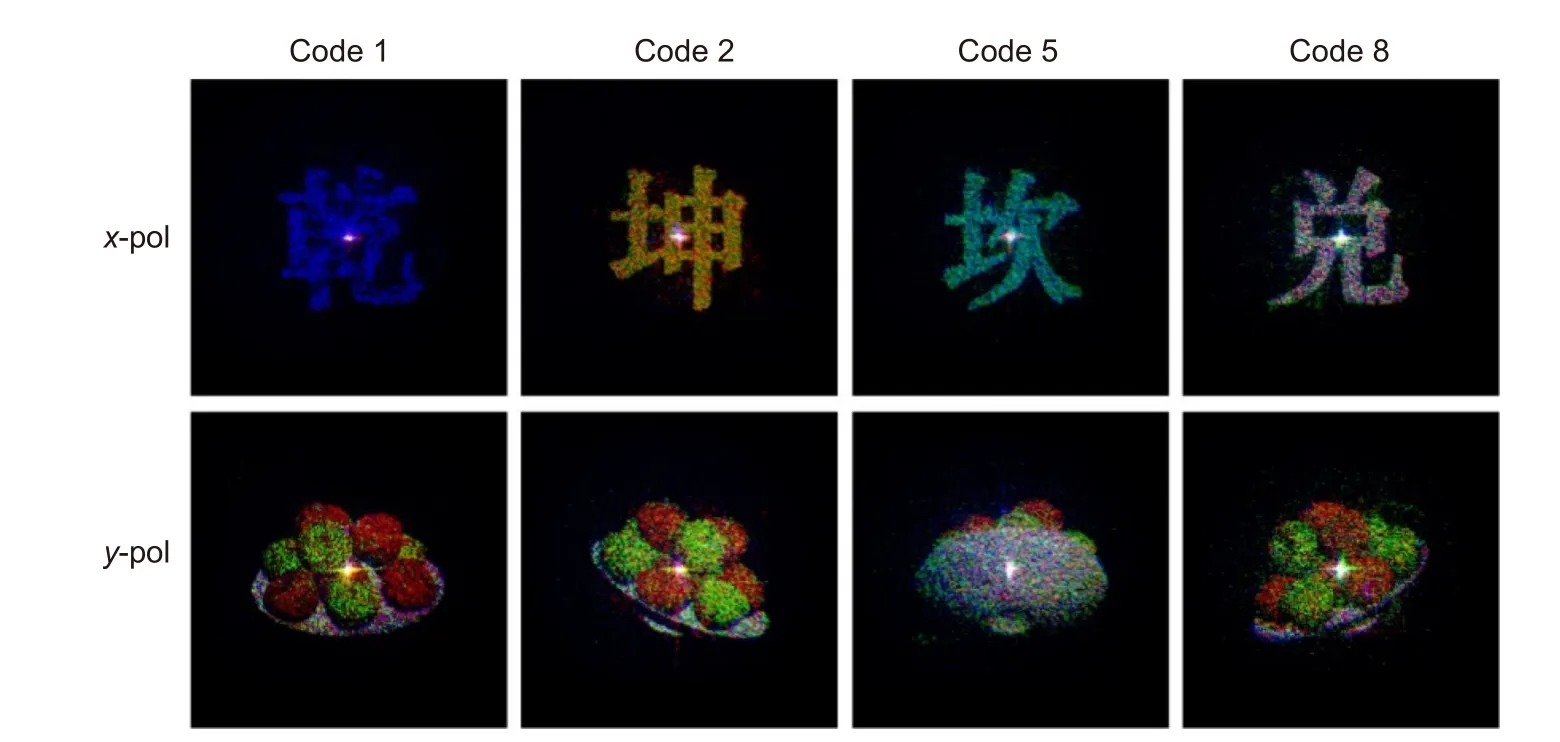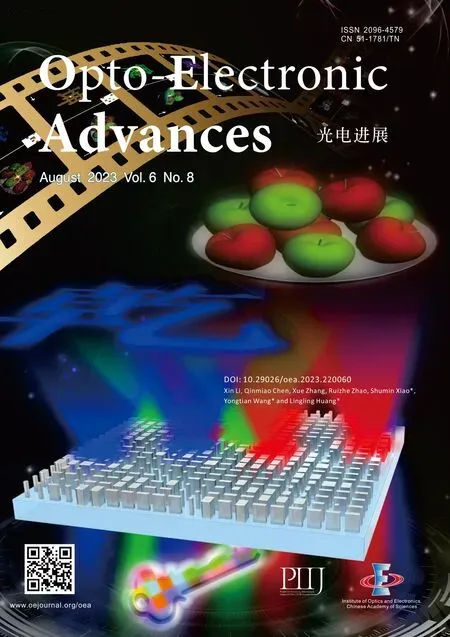Time-sequential color code division multiplexing holographic display with metasurface
Xin Li, Qinmiao Chen, Xue Zhang, Ruizhe Zhao, Shumin Xiao,4,5,Yongtian Wang and Lingling Huang
Keywords: metasurface; color holography; dynamic display; code division multiplexing
Introduction
Holography possesses powerful flexible light control and reconstruction abilities, and it has demonstrated significant application value in the acquisition, processing, modulation, storage, and display of optical information. Typically, as a thin hologram, a computer-generated hologram (CGH) without particular optimizations only records the wavefront information for a certain operating wavelength, and a reconstructing beam with different wavelengths leads to a magnification effect1. Thus, realization of color computer-generated holography has attracted considerable attention because of its capability to reconstruct different wavefronts at distinct wavelengths.There are two main categories of methods that can be used for realizing color holography: the first type involves the aspect of algorithms, including spatial division methods and depth division methods2,3, and the other type involves the aspect of systems, which includes time division multiplexing (TDM) and spatial division multiplexing (SDM)4,5. However, these algorithms lead to multi-order images, which results in low efficiency for the desired color images, and SDM system leads to a setup with a large size, whereas TDM architecture only requires a high performance spatial light modulator(SLM) to realize a compact system. Additionally, as core devices, commercial SLMs have considerable challenges,including a large pixel pitch when compared to the wavelength and strong background noise due to dead zones. An ideal alternative to the current commercial SLM is the use of an optical metasurface.
Metasurfaces consist of subwavelength nanostructure arrays, and they are considered as the next generation of optical elements because of their excellent performance in controlling light properties such as amplitude6,7,phase8-10, frequency11,12, polarization13,14, and orbital angular momentum15,16. Owing to the advantages in subwavelength pixel pitch, ultra-thinness, and multiplexing capabilities, metasurface holography, including optical data storage, information display, and counterfeit protection, has been extensively investigated17-23. Multicolor metasurface holography is a significant application with several resolutions. The color CGH algorithms mentioned above are direct methods for realizing color metasurface holography24,25, where correct images are reconstructed in the region of interest, while multiple orders out of region become background noise. Polarization multiplexing methods can decrease the influence of multiple orders from an algorithm via a linear or circular analyzer26,27. Additionally, narrow-band nanostructures consisting of supercells or different color regions on metasurfaces correspond to another common method for color holography28,29. In some of these methods,the images are reconstructed in the far field and color printing is realized in white light illumination operating mode30,31. A heterogeneous metaatom consisting of both hydrogenated amorphous silicon and gold nanorods was proposed for dual-band holographic reconstruction32.And this dual-band holographic operation can also be realized based on a two-layer metasurface33. Moreover,harmonic generation is also available to generate bicolor images34, where C3and C2nanoantennae are designed for comparable intensities of second-harmonic generation for red and third-harmonic generation for blue. By combining the propagation phase with the geometric phase to generate a phase difference for two wavelengths,another dual-wavelength metasurface holography scheme was realized with wavelength decoupling35. Furthermore, building a phase or amplitude library with dispersion is an intuitive strategy for the design of multiwavelength metasurface36. However, above methods only realize static color reconstruction once the devices are fabricated.
Although many efforts have been made to investigate active metasurfaces37-40, spatiotemporal manipulation is still a challenge. Nevertheless, code division multiplexing (CDM) metasurface holography introduces a new perspective41. Inspired by CDM in communications,code references apparently increase the number of manipulation channels and function as tunable illumination assistants for realizing dynamic light modulation. In addition, more channels can be available by introducing other multiplexing methods into metasurface holography because of the compatibility of the CDM. These provide an opportunity to further improve the dynamic modulation potential of color holography.
In this study, we store various images and a color video in a single metasurface by integrating multiwavelength CDM and polarization multiplexing techniques to enhance the information capacity. Furthermore, a dynamic display is realized with the assistance of a tunable light source and an active optoelectronic modulator. The channel-separated iterative optimization algorithm encodes all the information of the references and targets into CGHs. A titanium dioxide nanorod array was designed and fabricated as a birefringent metasurface. 8 pure color Chinese characters and 8 color video frame images consisting of 48 monochrome images were successfully reconstructed using such a single metasurface, and the video was displayed dynamically with sequential illumination of code reference patterns. Multiwavelength CDM metasurface holography is an effective scheme for providing extra information channels and vivid colorful holographic videos. It is expected that this method can be employed in high-density optical data storage, optical information encryption, multiwavelength manipulation, dynamic optical displays, and other fields.
Principle and design
CDM provides an alternative technique to simultaneously allow multiple information manipulations over the same bandwidth42in wireless cellular and fiber communication. A series of orthogonal ordered codes are selected as signature waveforms, and they are combined with target signals and summed before transmission.Then, the receiver decodes her/his signal from the entire information via autocorrelation with the specific code42.Essentially, a new information dimension originates from the order of the code signal. Hence, for a free-space two-dimensional (2D) optical information system, similar to a group of specific timing signals selected as codes in communications, a series of well-chosen wavefront distributions can be considered as equivalent candidates to the codes. Specifically, in optical CDM holography, a series of code beams are introduced to encode distinct object information into a single CGH, and these code references are key for decoding the information in reconstruction. The orthogonality of codes is supposed to be obeyed if the concept of CDM from communications is directly applied, which is necessary for communication. Here, because the information for both objects and reconstructed images is mathematically represented by 2D spatial continuum functions, an intuitive definition of orthogonality is defined based on the Hadamard product as follows:
where◦denotes the Hadamard product of two distributions,E1(x,y) andE2(x,y). It is noteworthy that owing to the redundancy property of a hologram that provides a high information density1, a part of the hologram can be used to record various pieces of information corresponding to distinct reference beams. This indicates that even if there is an overlap between different codes for the non-orthogonal case, the overlapping area of the hologram can still be used to record and reconstruct distinct information successfully when different code beams illuminate the entire CGH. Consequently, orthogonality is not strictly abided by in the implementation of code selection in our CDM method. Then, CDM holography can be described as follows:
whereP{}denotes the propagation of light from the hologram plane to the image plane,Cm(x,y) andCn(x,y)denote different code beams,F{}is an encoding process of CDM holography,tm(x,y) is the mathematical expression of target object information on the hologram plane,andarepresents a complex constant.tm(x,y) is acquired based on the principle of propagation, which is Fourier transform in our verification for the target image plane locates in spatial frequency domain.
Wavelength can be an independent channel because of the principle of the independent propagation of light in linear materials. Although wavelength division multiplexing (WDM) in optical communications is an effective way for increasing the information capacity by introducing wavelength as another light manipulation dimension, an SDM system consisting of separated sources and modulators for different wavelengths is required. Correspondingly, for CDM holography, it is thought that a strict and precise light manipulation requires orthogonal code beams, where the area occupied for one code pattern cannot be used for another code pattern. Nevertheless, orthogonal codes decrease the flexibility of this method. An alternative method involves independent manipulation of the wavefront at distinct working wavelengths via each modulator unit42. Although this is an excellent way to precisely modulate the wavefront, it also increases the difficulty in practical design. For multiwavelength CDM, given that the code references are the main design freedoms, along with the redundancy and robustness properties of holograms, even there are overlapping areas for different color code patterns. Furthermore, the reference beam with the correct color code pattern can read its distinct corresponding optical data and reconstruct the correct wavefront.
The scheme of the multiwavelength CDM metasurface holography is shown in Fig. 1(a). When a given color code beam with specific wavelengths and polarization state illuminates the hologram, the corresponding color holographic image is reconstructed. We utilized 8 code patterns with red, green, and blue (RGB) as the keys and encoded the corresponding color images into the CGH to verify the feasibility of metasurface holography for dynamic multiwavelength manipulation. As shown in Fig.1(b), 8 pure color patterns with quasi-random color square blocks in a 7×7 matrix were chosen as the code references. The block selection in each code pattern is not completely random because the superimposition of all 8 color patterns should cover the entire metasurface and excessive overlap can result in high-information density. This in turn can lead to the failure of the optical data storage43. A total of 54 pure color square blocks (as a group) were selected for 24 monochrome information channels for a specific polarization (8 code channels and 3 color channels). It is worth noting that Fig. 1(d) shows 8 multilevel color images from a color video, and when code patterns from code1 to code8 illuminate the metasurface sequentially with vertical linear polarization, the video is displayed on the observing plane.

Fig. 1 | (a) The schematic of color holographic display based on CDM and polarization multiplexing. The target color image can be reconstructed only when the correct code key reference illuminates on the metasurface with a correct linear polarization state. (b) Exhibits eight color code references. (c) and (d) Color images encoded and recorded for horizontal and vertical polarization channels, respectively.
The flowchart of three-wavelength CDM hologram encoding process is described in Fig. 2. The color components of all images and codes are separated and encoded into three groups of independent CGHs with RGB colors via a modified Fidoc algorithm respectively. In the encoding process for a specific color channel, all codes and corresponding target images are involved in the iterative optimization process in parallel, and a weighted sum is applied to integrate the information for acquiring a hologram in the current iteration. When the image quality of the reconstructed results satisfies the requirement, the hologram can be outputted as the final CGH for this color channel (for details, please see Supplementary information Section 1). After optimization, they were synthesized as a multiwavelength CDM CGH. Horizontal and vertical linear polarized lights provide another dimension for information storage and reconstruction based on the feature of birefringent metasurfaces, and distinct color images can be encoded or decoded via the exact same code in different polarization channels. Consequently, 16 different color images were recorded in a single metasurface in our verifications.

Fig. 2 | Flowchart of optimization algorithm for dynamic multiwavelength CDM CGHs generation. MFA represents modified Fidoc algorithm for CDM holography according to ref.41. The target images are divided into three series of monochromic images for different color components, and they are encoded and synthesized as a multiwavelength CDM CGH.
The metasurface hologram consists of an optimized nanorod array, where the nanorods are composed of titanium dioxide with its high refractive index and low loss in the visible range, and the substrate is composed of silica. In our design, the height of the nanorod was 600 nm, and the period of the unit cell was 360 nm to match the pixel pitch of the image source for the code beams.Considering the complexity and accuracy of nano-fabrication, the length and width of the nanorods were limited to the range of 50 nm to 310 nm. In the simulation and design, a rigorous coupled wave analysis (RCWA) method was applied to analyze the electromagnetic response of the unit cell. The results of the transmission coefficientstxxat 633 nm (R), 532 nm (G), and 460 nm (B)working operating wavelengths are shown in Fig. 3, and the transmission coefficientstyyat each wavelength are symmetrical withtxxvia axis rotation. Furthermore,these results form a dictionary for the geometry selection of each nanorod after obtaining color CGH phase profiles. Owing to the robustness of a hologram, each meta-atom, i.e., the unit cell of the metasurface hologram, does not have to offer a precise phase response at each working wavelength. For a specific nanorod, a maximum of 4 channels exist in our verifications (2 color channels due to the selection of code references and two polarization channels as shown in Fig. 1). The optimization function for the size of nanostructures is defined as follows:

Fig. 3 | (a) Schematic illustration of a titanium dioxide nanorod fabricated on a glass substrate, where H represents the height (600 nm for the samples), P denotes the period of a unit cell (360 nm in our verification), and W and L are the width and length of nanorods, respectively, whose ranges are from 50 nm to 310 nm. (b-g) The simulation scanning results obtained via RCWA for parameters optimizations involving incident wavelengths of 633 nm, 532 nm, and 460 nm. (b-d) and (e-g) are amplitude and phase transmission coefficients txx of nanorods, respectively.
where exp(iφx) and exp(iφy) are target CDM CGHs for two polarization channels, andΩrepresents the color channel (for instance, the nanorods located in the overlapping area for code1-code8 should be optimized for G and B). Then, the length and width of the nanorods were determined from the transmission coefficient dictionary to ensure that Eq. (3) was minimized.
Results and discussion
We fabricated metasurface samples for experimental verifications. Furthermore, their scanning electronic microscopic images are shown in Fig. 4(a) and 4(b). In addition, Fig. 4(c) exhibits the experiment setup. The nanorod array had 1323×1323 units with an aperture of 476.28 μm×476.28 μm. The light emitted from a supercontinuum laser source is collimated by a spatial filtering system consisting of an objective, pinhole, and lens.The code patterns are loaded on a digital micro-mirror device (DMD) and illuminated on the metasurface sample, where another 4f architecture is employed to filter out diffraction noise via the pixelated structure of the DMD. Then, the light emitted from the metasurface is collected by an objective and imaged on a camera. A half-wave plate was used to control the polarization state of the incident beam, and an analyzer was utilized to filter out the desired linear polarized light. As shown in Fig. 4, a single DMD is applied for code generation and TDM technique is employed, where R, G, and B lights are emitted sequentially, and the corresponding code patterns are loaded synchronously. Color images are then displayed by combining these three channels due to the persistence of vision.

Fig. 4 | (a-b) Top and oblique views of scanning electron microscopy images of fabricated samples, where the scale bar represents denotes 1 μm. (c) Experimental setup. LS, the supercontinuum laser source; OB1 and OB2, objective lens; PH, pinhole; L1-L4, convex lenses; P1 and P2, polarizer and analyzer; HWP, half-wave plate;DMD, digital micro-mirror device; AP, continuously variable iris diaphragm; MS, metasurface; CCD, charge coupled device.

Fig. 5 | Experimental results of multiplexing metasurface holographic color display. The images on the first row are reconstructed with horizontal linear polarization state and four frames from a video with vertical linear polarization are shown on the second row (see Movie S1).
To demonstrate the capabilities of the proposed method, we selected eight Chinese diagrams and frames to form a video as the target images as shown in Fig. 1(b)and 1(c). The reconstructed color images in experiments are shown in Figure 5. Selecting either distinct code patterns or polarization states can offer completely different information channels for a single metasurface. Colorful Chinese characters and multilevel color frame images were successfully reconstructed via code illumination with a specific linear polarization (see Movie S1). It should be noted that bright spots in the center of the results, owing to the unavoidable fabrication errors of the nanorods, the remaining transmitted light from crosspolarization, and slight deviations from the desired transmission coefficient. The strong speckle in the images is attributed to the interference by undesired scattered light, including a slight misalignment between the code illumination and metasurface, and settings of the optical elements in the experiment. Further optimization in the design process and experiments and employment of optical elements with high performance can reduce their influence and bring a higher quality reconstruction. Time sequent illumination of color code patterns leads to the change in reconstructed images. This brings vivid colorful video display (see Movie S1), which indicates that the proposed multiwavelength CDM metasurface holography is an effective way to achieve dynamical manipulating of multiwavelength wavefront.
Multiwavelength CDM metasurface holography is not restricted to the aforementioned three specific wavelengths and limited the number of code references.Additionally, more wavelengths can be realized using the proposed method because the information density provided by the code dimension is sufficiently high. Introducing more wavelength channels and a larger database of codes can further increase the information density of a metasurface, which can be applied to hybrid wavelength-code reference-polarization multiplexing,such as three-dimensional display44or hyperspectral light manipulations, with independent wavefronts for each channel. Meanwhile, neither incorrect polarization nor a wrong color code illumination can decode information from the metasurface (see Supplementary information Section 2). Furthermore, time-sequence illumination can provide another key for the correct interpretation of hidden messages. This demonstrates that the multiwavelength CDM metasurface holography has high security, i.e., even if low amount of information is leaked to an eavesdropper, she or he can only decode incorrect information.
There are several multiplexing techniques for metasurface holography based on the variance of the wavefront of incident light such as the point-source method45and OAM multiplexing methods21,46. However, the information of reference beams in these methods is limited, and many spatiotemporal freedoms are not fully utilized. For the point-source method, the position change of the point source only leads to shifts or magnifications of reconstructed images along the horizontal,vertical, and axial1, which implies that there is multiorder noise on the observation plane. The topological charge of the vortex beams is the main parameter for multiplex manipulation, which only provides a single extra dimension for light modulation. In CDM metasurface holography, the code patterns are two-dimensional,which results in high information density and flexibility.In addition, CDM metasurface holography has high compatibility, and it works well with other multiplexing light manipulation techniques as shown in our verifications. Accordingly, storing the information of 48 monochrome images is not the upper limit for multiwavelength CDM metasurface holography, and it is easy to realize more states of light manipulation by introducing more multiplexing channels.
The dynamic display is realized owing to the time sequential reading out optical information driven by a DMD. In our verifications, a TDM system is used for color pattern illumination because it is simpler than an SDM system. Moreover, when compared with traditional holographic displays, multiwavelength CDM metasurface holography provides a much higher spatial bandwidth product with a subwavelength pixel pitch. Benefited from this advantage, even a small optical element can record and display an entire color holographic video,which enables the realization of a compact system and has huge potential for practical applications.
Conclusions
A multiwavelength CDM metasurface is introduced to achieve dynamic color holography under the external excitation of color code references with DMD. This type of optical CDM introduces a new manipulation dimension,which enables the recording of high-intensity optical information in a single metasurface via the combination of our improved iterative algorithm and elaborately optimized design of metaatoms. We reconstructed a total of 8 distinct color Chinese characters and displayed a short color video from two polarization channels via the same metasurface hologram, where 48 grey-level monochrome images were stored and read out successfully. Although a TDM illumination system was employed in our verification, simultaneous wavefront manipulation at each working wavelength can be realized by an SDM architecture. This technique demonstrates high compatibility with other multiplexing methods, which leads to higher flexibility, information density, and security. This method is promising for applications in information display, data storage, optical encryption, and other fields with dynamic or multifunctional light manipulation.
Acknowledgements
The authors acknowledge the funding provided by the National Key R&D Program of China (2021YFA1401200), Beijing Outstanding Young Scientist Program (BJJWZYJH01201910007022), National Natural Science Foundation of China (No. U21A20140, No. 92050117), and Beijing Municipal Science & Technology Commission, Administrative Commission of Zhongguancun Science Park (No. Z211100004821009). X. Li acknowledges the support from Beijing Institute of Technology Research Fund Program for Young Scholars (XSQD-201904005). The authors also acknowledge the fabrication and measurement service in the Analysis & Testing Center, Beijing Institute of Technology.
Competing interests
The authors declare no competing financial interests.
Supplementary information
Supplementary information for this paper is available at https://doi.org/10.29026/oea.2023.220060
 Opto-Electronic Advances2023年8期
Opto-Electronic Advances2023年8期
- Opto-Electronic Advances的其它文章
- A novel method for designing crosstalk-free achromatic full Stokes imaging polarimeter
- Cover
- Advancing nonlinear nanophotonics: harnessing membrane metasurfaces for third-harmonic generation and imaging
- Third-harmonic generation and imaging with resonant Si membrane metasurface
- Direct field-to-pattern monolithic design of holographic metasurface via residual encoderdecoder convolutional neural network
- Planar peristrophic multiplexing metasurfaces
